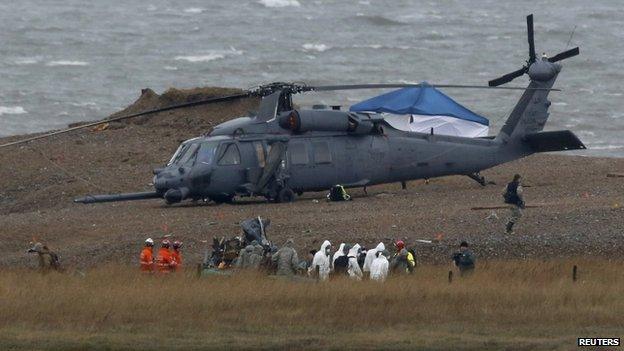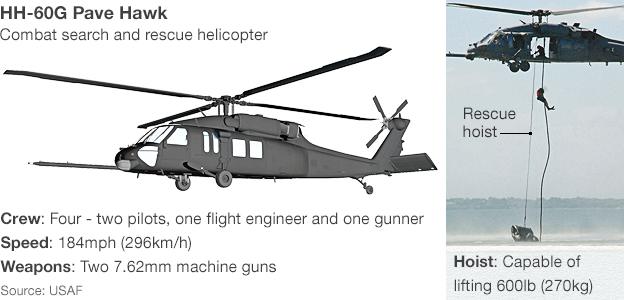Helicopter crash: Bodies of USAF crew removed
- Published

Staff Sgt Afton Ponce, Capt Christopher Stover, Technical Sgt Dale Matthews and Capt Sean Ruane were killed
The bodies of the United States Air Force (USAF) crew killed in a helicopter crash in Norfolk have been removed from the scene.
Capt Christopher Stover, Capt Sean Ruane, Technical Sgt Dale Mathews and Staff Sgt Afton Ponce died in the crash in Cley next the Sea, north Norfolk.
The HH-60G Pave Hawk from the 48th Fighter Wing, based at RAF Lakenheath in Suffolk, came down on Tuesday.
The USAF said no warning or Mayday message was made before the crash.
The Pave Hawk was armed with 600 .50-calibre bullets and a 9mm side-arm with 15 bullets, which were scattered across an area the size of a football pitch.
'Limited flight operations'
It was on a low-level night training mission, which Col Kyle Robinson, Commander of 48th Wing described as a routine flight.
Col Kyle Robinson said he could not imagine the heartbreak of the families involved
"No warning was received about problems with the helicopter," he said.
"Yesterday, we did not fly across the whole 48 Fighter wing, showing our support and condolences for the members of the D6 rescue squadron.
"We will start some limited flight operations today as we continue forward."
He added that it was "still too early to speculate as what caused the crash and make all long-term decisions based on that".
Captains Stover and Ruane were pilots, while Tech Sgt Mathews and SSgt Ponce were acting as special mission aviators.
Col Robinson said they were "flying to a gunnery range in Holbeach [Lincolnshire], and used that frequently for training".

Each body was removed from the crash site and taken to the Norfolk and Norwich University Hospital
He said the crew, who were members of the 56th rescue squadron, had been in the air force "anywhere from a couple of years to upwards of 16 to 17 years".
"As you would imagine, with most crews, there is a range of experience levels and in general, you have some of the more experienced people [who] will fly with some of the less experienced people and this crew is no different.
"They are all highly qualified in what they did and capable."
'Dignified and respectful'
Police, air accident, RAF and US investigators have spent the last two days at the scene of the crash.
The USAF, supported by the Ministry of Defence, will lead the continuing investigation into the circumstances of the crash, with Norfolk Police handing over their inquiry.
A 400-metre police cordon is expected to remain in place at the scene until Monday and the public have been asked to stay away.

Norfolk Police Ch Supt Bob Scully said the "dignified and appropriate removal of the bodies" was carried out by USAF officers and staff "under the supervision of Her Majesty's Coroner".
Speaking before the removal, he said it had been a "real sadness that we've not be able to recover the bodies sooner".
"It's a very difficult investigation, on very difficult terrain."
He added that the recovery of the wreckage and munitions and "making good any environmental damage caused by the crash" would take several weeks.
The bodies have been taken to the Norfolk and Norwich University Hospital.
Norfolk Coroner Jacqueline Lake said she would not be carrying out an investigation into the deaths because the airmen had a "relevant association with a visiting force" under the Visiting Forces Act 1952 and Coroners and Justice Act 2009.
Col Robinson added that had been a "tragic, sudden loss".
"The Liberty Wing feels as though it has lost members of its family, and we stand by to support one another and these airmen's families during this difficult time."
Flowers have been left at the gates at RAF Lakenheath and a fundraising page has been set up online to offer financial support to the families.


The HH-60G Pave Hawk, a version of the US Army's Black Hawk helicopter, is used by the US Air Force for combat search and rescue, mainly to recover downed aircrew or other isolated personnel in war zones.
The helicopter, made by Sikorsky, has been used in numerous military missions, in Iraq and Afghanistan, as well as civilian rescue operations after disasters like the 2004 Boxing Day tsunami in Sri Lanka and Hurricane Katrina in the US in 2005.
The Pave Hawk, which came into service in 1981, has a four-man crew and can carry up to 12 troops.

- Published8 January 2014
- Published8 January 2014
- Published8 January 2014
- Published7 January 2014